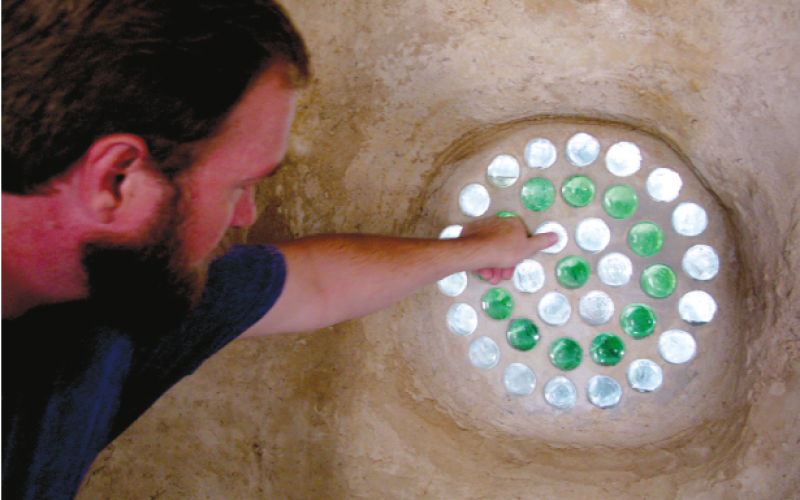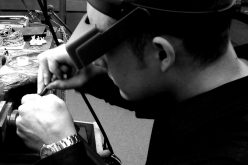
GARFIELD — For three years, heavy sack by heavy sack, Lisa and Paul Majors’ home has grown from their patch of paradise nestled on the northeast side of Benton County’s Posey Mountain.
The Majors purchased their 20 acres after they married a few years ago.
“We were looking for a way to have less of an impact on the earth,” Lisa says while showing visitors how they modified the plan for earth bag dome homes to fit their site’s lack of dirt. An earth bag home uses bags filled with dirt to create what amounts to an igloo. Without enough dirt, they turned to what is available: crushed limestone from a nearby quarry.
So, scoop by scoop, bag by bag, at a rate of 20 or so bags a day on days when they build, the walls have risen.
Used tires packed with rock or soil — or even crushed beer cans — can become a foundation, or a wall. In fact they have as Lisa and Paul experiment.
Once the walls are up they are covered with stucco or plaster, or even site-made adobe, the ripple of tires and bags becomes a smooth surface. The mass of material in the walls — up to two feet thick — creates a stable oasis inside.
“We’ve been learning as we’ve been going,” Lisa says as she shows where plaster is beginning to flake from the bags. “Too much sand, or too wet, or something — we keep trying. If it comes off, we just put more back on.”
What she and Paul are doing is nothing more than what early American settlers, and the Native Americans before them, did. They are making a home with what’s on hand. Sure, they’ve added modern twists — electricity, Portland cement, rows of glass bottles that serve as light ports — but they’re still using the stuff that’s on hand.
Their bedroom was going to be a dome 25 feet in diameter and 25 feet tall. At some point, Lisa said, it turned into a green roof. So, using wooden beams and tongue-and-groove planking from a sawmill in Eureka Springs, they built a flat roof on top of 8-foot-tall walls. On the flat roof they will pile dirt and plant plants. Tar paper, a swimming pool liner, expanded-bead insulation that will create a slope, another pool liner, then soil. The slope will funnel water to a yet-to-be-built cistern.
“We get 40 inches of rain here — so surely we can supply all our own water without the expense of drilling a well. Homes like this in Taos (N.M.) get by on 10 inches of rain a year. We can do it on 40,” Lisa says.
Their home will be a series of domes linked either by portal doors, or — like what links the bedroom to the living room — a curving sun room.
The skeleton of the sun room is taking shape. Windows purchased on the cheap — and that’s Lisa’s goal, to buy things on the cheap, or better yet, get them free — will create a south-facing wall that in winter will act as a solar heater. A smiling sun mosaic graces one wall.
The mosaic was composed using broken tile.
Lisa says she discovered tile stores have boxes of broken tile. She once asked if she could have their broken pieces. They rolled out three pallets stacked with boxes.
The sacks the couple fill with crushed limestone are misprints and rejects from a company that prints writing on the bags. It’s a way to keep something from hitting a landfill.
Paul, an HVAC guy, threw away empty refrigerant bottles — they look like small, green propane bottles.
“Those surely have some use, so we’ve been saving them,” Lisa says. Another item not in a landfill. A wall of them stands stacked chest high between two trees. Problem is, she hasn’t figured out a use. But she’s certain she will.
Beer bottles? Most everyone with a taste for hops buys them — and throws them away.
Lisa uses a glass saw to cut the bottoms off, then uses a bit of tape to connect two bottoms to create a glass tube: Viola! Colorful tubes that she is building into the walls of the domes. More items, not in a landfill.
The glass and broken pieces of colorful tile all become material for Lisa’s artistic endeavors, which she notes is her professional side. She uses the broken tile and glass to create the mosaics, such as the smiling sun, that dot the evolving home.
The bedroom is heated by what amounts to an invisible stove. A black barrel is the only indication, and it’s not an obvious one, that the room is heated by fire. The barrel is part of a rocket stove system, which burns smaller pieces of wood — think branches, not logs — in a highly efficient combustion chamber. The exhaust doesn’t go up a chimney; rather, it goes through ducting in a bench seating area, then vents outside. The bench is filled with crushed rock, which absorbs the heat and slowly releases it into the room.
While the bedroom stays cool even in summer, a tiny air conditioner is a nod to Paul: After a hot day of fixing broken air conditioners, he craves a cool blast of air, Lisa says. It’s a compromise with their goal to use as little electricity as possible.
The pair plan to install enough photovoltaic panels hooked to batteries and live outside the power grid. They hope in a year they can cut the cord.
Their pursuit of self-sufficiency carries over to the half-acre garden and a chicken coop. Lisa says the chickens are allowed to roam free; however, the rooster doesn’t like men, so the entire flock has been imprisoned until the visitors leave. The coop has a chicken-wire run to keep marauders out (they battled a mink that killed much of their original flock) and a small roosting room, which has walls that are things of beauty: branches a couple inches in diameter, a foot long, stacked with the round ends exposed to the outside, mud packed between as chinking. The wood, Lisa says, came from the trees cut to clear the garden spot.
A nearby rabbit hutch contains a buck, a couple of does and two babies — the remaining two from the last round of baby rabbits. They discovered the phrase “breed like rabbits” is true. She gives away the bunnies. Asked why they don’t use the rabbits for meat, Lisa says she can’t bring herself to kill them.
Which is not to say Paul and Lisa don’t eat meat: The deer in the area are fair game. Their rich, dark meat stocks the freezer.
The couple currently live in a 26-foot travel trailer, so there’s not enough of a kitchen to can their garden’s bounty. But Lisa says she’s drying what she can for use this winter.
Most of what they’re eating comes straight from their garden. They tilled their garden once to get it started, but they plan to use a no-till method from now on. Cardboard, newspaper, anything biodegradable, can be used to fight back weeds and help build the soil. Chicken and rabbit litter goes into the garden, as does all the household waste that will degrade.
“We want to be better stewards of the land. This has helped me discover who I am, how to be better to the earth and help my body,” Lisa says. “Yes, it’s been work, but I’m healthier, I’m having far less of an impact on the earth than I did just a few years ago. We were tired of being part of the problem — we want to be part of the solution.”
To accomplish the goal means their lives now revolve around the house and garden. When some people find out what the couple is doing, their eyes glaze over.
“It’s hard to find people who are what we call ‘awake,’” Lisa says. “But more and more people are waking up to finding ways to protect Earth, to make the future better.”
When talking about being awake, Lisa begins to sound spiritual.
Then she starts talking about God.
“I used to be a Bible-thumping Baptist,” Lisa says. A couple of Bibles sit on the nightstand, next to the bed that’s the centerpiece for the bedroom dome.
“But I’m not that anymore — I’m a dancing Christian. We’ve got to live by some set of rules — why not Christ? But I still believe. God is all around us. He made this. We live to express God’s creation.”
Lisa’s not afraid to talk politics, either.
“I’m outraged by both parties and what they’re doing,” she says, passion rising in her voice. She talks about what’s wrong with both major parties.
“The only way to stop it is to get involved,” she says. She voted for Ron Paul. She’s not sure how she’ll vote come November.
But the visitors, even though they gladly engage in talking about religion and politics while standing in the woods of Posey Mountain, that’s not why they came.
The domes, that’s what brought them.
But it’s not the domes. Not really.
Those domes represent far more than living areas: The domes are metaphors for ideas.
• Build your own, Earth-friendly home.
• Try. Fail. Try Again.
• Feed yourself.
• Be a scavenger who uses/reuses/recycles/repurposes things society discards.
• Eliminate debt.
• Don’t have a utility bill.
• Find the beauty in the simple.
“We’re not selling a system or product,” Lisa says. “We are offering a way of living better.”
Heavy sack by heavy sack, simply idea after small actions, Lisa and Paul are finding their own way in their version of paradise.










